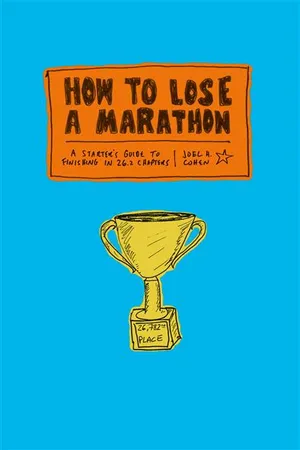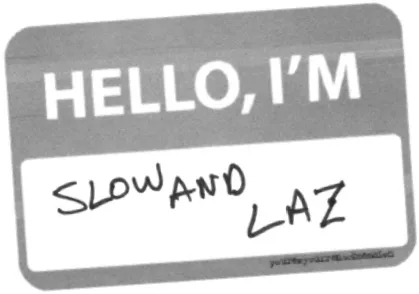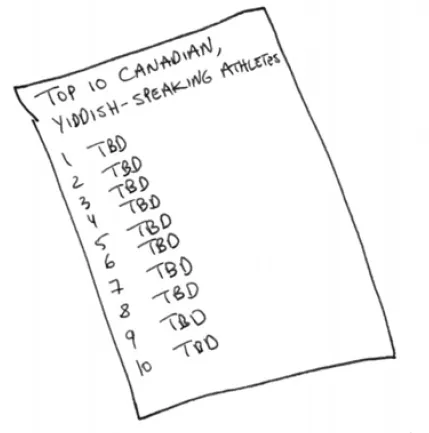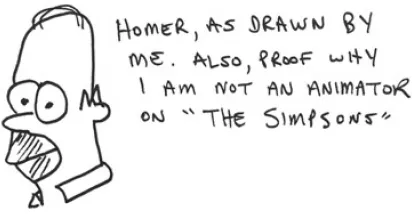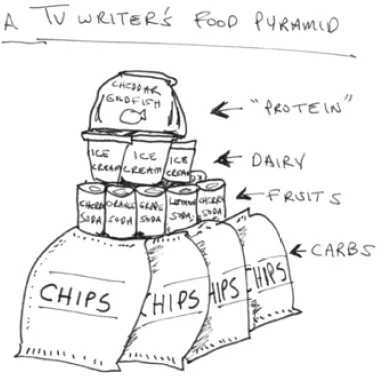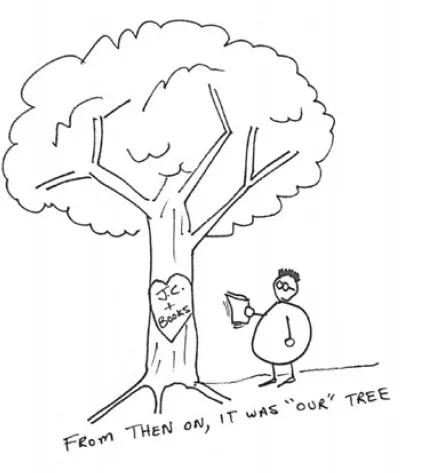![]()
HONEST SELF-ANALYSIS
1
Pudgy, slow, lazy,
Not a good personal ad,
Yet sadly, the truth.
—INTROSPECTIVE HAIKU, JOEL COHEN, FREQUENT SELF-QUOTING AUTHOR
I’m not fast, but I am lazy.
I’d like to deal with these one at a time, since I am too lazy to deal with them both at the same time.
First, let’s explore my laziness. I’m so lazy that before writing this book, I googled “how many pages does a book have to be.” The answer suggested the bare minimum is forty thousand words. This book is not forty thousand words. Therefore, it may not even be a book; you may be reading a brochure, a flyer, or a long-winded fortune cookie. However, what you are holding is with certainty the product of a lazy person.
If you aren’t convinced yet, let me tell you that I have an electric toothbrush, a product meant for people too lazy to move their hand in small circles for thirty seconds. I bought an electric toothbrush to avoid that torture and then, when the battery ran out, I was too lazy to reach over and place it in the small holder that recharges it. This extreme level of sloth is exactly why now, every night, I find myself moving my hand in small circles for thirty seconds. I’m so lazy I’ve chosen to do the “work” of brushing my teeth just so I can avoid doing the “work” of plugging in my toothbrush.
I am also not fast. Not even close. Not even close to close. I’m almost the opposite of fast. (If only there was a word for the opposite of fast—it would come in so handy right now.)
I haven’t always been not-fast. There was a time where I would even have described myself as “speedy.” In fact, when I was younger, I was the fastest runner in my grade school class.
Now, this section is called “Honest Self-Analysis,” so let me be up-front about the fact that my grade school class was made up of only six people—four boys and two girls. You might think that’s a very small class until I tell you that my grade school was a Yiddish language school in Calgary, Canada. Now you’re thinking, “They managed to find six people for that?!”
As fast as I was in my tiny class at the I. L. Peretz School, I couldn’t keep reality at bay forever. While the list of Yiddish-speaking Canadian sprinters is long and distinguished, I was about to learn that I would not join the esteemed ranks of Gordy “Lightning” Abramowitz and the great Doug “Flash” Mendelson.
My wake-up call came when I left this little academic shtetl and entered the public school system for grade seven. There, at John Ware Junior High, I went out for the track team and returned humiliated.
It seems that when you expand your class size beyond six, and beyond the children of parents who believed Yiddish was a necessary tool for success in the twentieth century, athletic competition becomes, well, competitive.
That first track practice at John Ware gave me a chance to study the backs of my new classmates as they sped past me. I also got to see their sides as they sped past me for a second time. Then, I watched them in profile as they passed me for the third and fourth times. It was very clear—I was a slow runner, and with all this watching my peers, a bit of a stalker. At the Peretz School, I thought I was the rabbit that grey-hounds chase at the dog track. At John Ware, I learned I’m more like the guy who carries a scoop and picks up after the dogs when the race is done.
Once I came to terms with my lack of running aptitude, I began to look for other sports I could also be bad at. Luckily, I found several. Basketball—horrible! Football—below average! Jai alai—never tried it, but bet on it once in Tijuana before I realized it was fixed. Yes, I was even bad at betting on sports.
Aside from one forgettable season playing Little League Baseball, the only organized sport I played, and still play regularly, is ice hockey. When I describe this as organized I mean I play in a league that has games starting at ten thirty Sunday night and ending Monday morning. To give you a sense of the quality of play, the team I’m on started in the silver level, then dropped to the bronze level, and now the league is desperately searching for a metal less valuable than bronze so they can create a new tier worthy of our play. (My guess: It will be tin or possibly rust.)
Though I play hockey regularly, I still suck at it. I’ve been playing for more than forty years, and I clearly peaked the very first time I put on skates. As a proud Canadian, being a bad hockey player is a problem. Even now, in my league in Los Angeles, I try to hide that I’m Canadian so my hockey ineptitude won’t reflect poorly on my homeland. In spirit, it’s a very patriotic act. I don’t know if anyone has ever been given the Order of Canada for denying they are Canadian, but this may merit serious consideration. Please write your local member of Parliament.
As bad as I am, I keep playing hockey because I enjoy it. I know I stink; I just like being out there, and making matters worse, I’m also a little competitive. Not the psycho competitive guy we all know and hate, but competitive enough that I try as hard as I can. The fact that I am trying to play well may come as a shock to my teammates on the Los Angeles Thunder, but it’s true.
I know I’m bad at sports, yet I still love sports. I love them as much as I hate exercise. The only exercise I like to do is through sports, because I need the competition to make the physical effort interesting. That very illogical contradiction explains (or doesn’t explain) where my head was at in the fall of 2012.
![]()
INSPIRATION FOR PERSPIRATION (AND EXPIRATION?)
2
“Some of the world’s greatest feats were accomplished by people not smart enough to know they were impossible.”
—DOUG LARSON, JOURNALIST
(If this is true, my doofus cousin is on the cusp of doing something awesome! Probably after he finishes “learning” acupuncture by watching YouTube videos.)
In addition to suffering from an allergy to athletics, in 2012, I was also working as a writer on The Simpsons.
If you’re not familiar with The Simpsons, Time magazine called it the “greatest television show of the twentieth century.” I started working there almost exactly at the start of the twenty-first century, thus ensuring it would not repeat its title. If not the greatest television show, few would argue that The Simpsons is the most successful. As I write this, we are in the middle of producing our six hundredth episode. The show is seen all over the world and has cranked out every piece of merchandise you could ever imagine. (Unless you’re imagining a Moe the Bartender PVC pipe connector. We don’t have those. Yet.)
I was incredibly lucky to even get a job at The Simpsons, and I am even luckier to somehow keep my job there. I work with an amazing team of people every day on a product that is loved all over the world, just like PVC pipe connectors. My workday there pretty much consists of sitting around a table saying things I hope are funny, while assistants bring in free lunch and coffee. In those rare moments when someone isn’t bringing us calories, there is also a room full of potato chips, soda, and ice cream just a few steps away.
It’s not like we are forced to eat sugary, delicious snacks. We can also eat salty ones. Or frozen ones. Yes, there are healthier options available, but to get to them, you have to pass the ice cream and chips, and who has the willpower to do that? The ice cream and chips are even closer to the writers’ room than the bathroom is. I’m not always in the position of having to choose between the bathroom and a Creamsicle, but when I am, Creamsicles win every time.
With this setup, my workplace at The Simpsons is a far better environment for raising veal than raising athletes. Seeing this opportunity, greedy executives once actually placed a baby cow in the writers’ room for a while. Sure, the cow was handy when we were looking for a line of dialogue for a bovine character, but other than that, it didn’t work out. Things got really awkward when people ordered burgers for lunch or used the cow’s milk for their coffee. You just can’t have that kind of tension in the workplace.
Sitting all day, taking in high-fat foods and churning out low-quality jokes, I really didn’t seem to be a candidate to run a marathon, but still, I did. Trying to understand how this happened, I examined the past with the fevered hindsight and desperation of someone trying to shore up an argument for their book. What I came up with was a lot of blame leveled at many external sources, with me ducking any myself. That’s what heroes do.
Specifically, I identified several scapegoats to fault for getting me into running:
1) Every teacher I’ve ever had. This long line of perpetrators stubbornly taught me how to read, against my will. I was never consulted in the matter, and still, before I knew it, I had a love of reading. Oh, how I wish there was a book like this one that could have extinguished my love of reading, but there wasn’t, and I consumed book after book. This literary spiral takes me to the next person I would like to blame—the author Christopher McDougall.
2) Were I blissfully illiterate, I never would have read the bestseller Born to Run by Christopher McDougall. The book details the fascinating Tarahumara Indians of Mexico. The Tarahumara can run all day without injury, with only the simplest sandals for shoes. This basic form of running really resonated with runners who suffer from chronic injuries and fueled the concept of barefoot running. The thesis behind barefoot running is that it employs the foot in the way it was intended to work in the human animal, and that the high-tech running shoes of today hamper that style and lead to injuries. An interesting idea, and certainly why you now see people out running in their actual bare feet or in the most minimal shoes possible. The exception to this is when you see someone in their bare feet running out of a sporting goods store carrying a pair of shoes. That is called shoplifting and is not covered in Mr. McDougall’s book.
As interesting as the idea of barefoot running was, the part of Born to Run that really surprised me was that there are people out there who love to run. I honestly never believed people could actually enjoy running. Don’t they know it’s exercise? Accepting that running is something some people like, I, chunky and curious, was intrigued.
3) Lastly, as with any list meant to spread blame, I’d like to blame my parents, specifically, my father. My father was even less athletic than I am (hard to believe, I know, but true). He passed away right about the time I started thinking about running. Without being fully aware of it, I realize now that this reminder of our mortality made me a little more health conscious and contributed to my decision.
Those three forces merged just like the Allegheny, Monongahela, and Ohio Rivers merge together in Pittsburgh. An apt reference since in 2012, my physical condition was a lot like . . . well, Pittsburgh.
Now, before the people of Pittsburgh get insulted thinking this is a disparaging comment, let me be clear. When I compared my physical condition to Pittsburgh, I meant that, like Pittsburgh, my body is also slowly spreading out while at the same time trying to revitalize...
